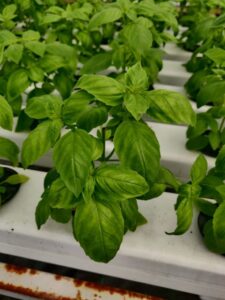Mastering Hydroponic Basil: From Seed to Harvest
Table Of Content
Basil is one of the world’s most beloved herbs—fresh, fragrant, and bursting with flavor. Whether you’re whipping up a batch of pesto, garnishing a Caprese salad, or infusing oils, basil adds that unmistakable touch of brightness to any dish. But what if you could grow it faster, cleaner, and all year round, without soil or garden space?
Enter hydroponic basil.
With the rise of soilless farming, hydroponics offers a smart, efficient way to grow basil indoors or commercially. It’s perfect for urban gardeners, home chefs, and even small businesses looking to supply fresh herbs on demand. From selecting the best basil varieties to setting up your growing system and maximizing yield, this guide will walk you through everything you need to know to cultivate vibrant, healthy basil using hydroponics.
Ready to grow basil the modern way? Let’s dive in.

Best Basil Varieties for Hydroponic Systems
Not all basil is created equal—especially when you’re growing it hydroponically. While all varieties can technically thrive in a controlled, soilless system, some outperform others in flavor, yield, growth rate, and resilience. Below are four of the most popular and rewarding basil varieties for hydroponic cultivation.
Genovese Basil—The Classic Culinary Choice
Genovese basil is the gold standard when people think of basil. Known for its large, lush leaves and sweet, slightly peppery flavor, it’s the go-to herb for pesto, pasta, and Caprese salads.
- Flavor: Sweet, traditional, with a hint of clove.
- Yield: High. Grows quickly and responds well to pruning.
- Growth: Fast-growing and bushy. Ideal for continuous harvests.
Hydroponic Bonus: Thrives in systems like DWC and NFT. It’s very forgiving for beginners.
Thai Basil—Aromatic and Bold
This variety brings a spicy, anise-like flavor that holds up well in high-heat dishes like curries and stir-fries. It has distinctive purple stems and narrow leaves, making it both beautiful and flavorful.
- Flavor: Spicy, licorice, with a bold punch.
- Yield: Moderate to high. Less leafy but more structured.
- Growth: Upright, slightly slower than Genovese. Prune to encourage branching.
Hydroponic Bonus: Appreciates stable temperatures and airflow. Great for chefs and specialty markets.
Lemon Basil—A Zesty Twist
As the name suggests, Lemon Basil offers a refreshing citrus aroma and flavor, making it perfect for teas, marinades, and desserts. Its bright profile is a favorite in Thai and Middle Eastern cuisines.
- Flavor: Light lemony tang with a sweet basil base.
- Yield: Moderate. Slightly smaller leaves.
- Growth: Slower-growing but sturdy. Needs frequent harvesting to stay compact.
Hydroponic Bonus: Does well in warm setups; works great with Kratky or ebb-and-flow systems.
Purple Basil—Striking and Subtle
This ornamental variety stands out with its deep purple leaves and mild flavor. While it’s less intense in taste, it’s visually stunning in salads and garnishes.
- Flavor: Mild, slightly clove-like, less sweet than green types.
- Yield: Moderate to low. Leaf density is lighter.
- Growth: Slower and a bit sensitive to light changes.
Hydroponic Bonus: Use it for visual appeal in mixed herb kits or as a premium market herb.
Quick Comparison Table
| Variety | Flavor Profile | Yield | Growth Speed | Best Use |
| Genovese | Sweet, classic basil | High | Fast | Pesto, salads, general cooking |
| Thai | Spicy, licorice-like | Moderate-High | Moderate | Stir-fries, soups, curries |
| Lemon | Citrusy, light | Moderate | Moderate | Teas, seafood, dressings |
| Purple | Mild, clove-like | Low-Moderate | Slow | Garnishes, salads, herbal blends |
No matter which basil you choose, hydroponics allows you to harvest fresh, flavorful herbs year-round. Start with Genovese if you’re a beginner or mix with others to explore bold flavors and niche culinary options.
Getting Your First Hydroponic Basil System Up and Running
Keep it simple because rookies burn themselves out trying to make complicated grow setups. For instant success? Use the Kratky system or a straightforward DWC bucket system.
Here’s what you need:
- An empty food-grade container (even a plastic tub with a lid)
- Net pots and clay pebbles
- Basil seeds (any of Genovese, Sweet Thai, or Lemon Basil work well)
- A grow light if you don’t reside in a sunny area
- Hydroponic nutrient (start with a 3-part nutrient solution like General Hydroponics Flora Series)
- pH meter or kit
Tip: Basil doesn’t prefer wet stems. Prop seedling bottoms up so roots rest in water.
I used to work as a consultant for a startup that accidentally lost 60% of its basil when the water level was too high. Stems were decaying in the water. Keep the water level below the net pot until the roots grow downwards.
Lighting: Give Hydroponic Basil the Power of the Sun (or Close Enough)
Basil is a light-colored plant. It needs 14–16 hours of intense light per day. Natural light works if you have that luxury. Otherwise, a full-spectrum LED is the way to go.
Avoid low-cost blue-dominant lights, they suppress growth. I changed a low-cost light with a Mars Hydro TS1000 once in a client’s basement grow. It paid off: basil leaves tripled in 10 days. Place your light 12–18 inches above the canopy and enjoy the dancing basil.
Dialing In Your Nutrients
Basil abhors salt buildup and pH changes. Keep your nutrient solution at:
- EC: 1.4–2.0 mS/cm
- pH: 5.8–6.2
- Temperature: 18–22°C (65–72°F)
My dietary regimen:
- Begin seedlings using half-strength nutrients.
- Strengthen up to full strength as they develop their second set of true leaves
- Change your reservoir every 10–14 days, and more frequently if the water smells strange.
And naturally, smell the water. Your nose should pick up trouble long before your basil.
How to Give Basil a Bushy Shape
If you don’t prune your hydroponic basil, you’ll end up with a bratty teenager-like bolt. It is going to grow uptight and flower and taste like grass clippings.
The second you see 3–4 sets of true leaves, top it off. Pinch the tip just above the second set of leaves. That teaches the plant to branch.
I’ve taken one basil seedling and turned it into a 2-foot-wide giant bush by topping it frequently and early. Pinch that new growth every week. You’re not harming the plant; you’re conditioning the plant to produce more.
The Easy Method of Learning from Your Mistakes
Before it’s too late, learn from the situation for better future experiences.
- Yellow Leaves
Typically low in nitrogen or off-range in pH. Test your solution. Back it down if pH is greater than 6.5 with pH Down. - Slime of the Roots
That’s root rot. Either light is finding its way into your reservoir, or water that is too warm. Foil or tape your container and get that temperature in check. - Basil won’t grow
Too low of lights, waterlogged roots. Check your water line. And make sure your EC is not off the charts—no one grows faster with extra nutrients. - Bitter taste
You waited too long. The leaves of basil become more bitter and tough as they get older. Harvest regularly and promote new growth.
Scaling Up? Here’s What You Should See
Hydroponic basil is an obvious crop for small-scale commercial growers. It is a high-turnover crop that grows quickly and fetches high prices on farm stands and upscale grocers.
Don’t become arrogant. After you’ve climbed up, you should:
- Automate nutrient dosing
- Check the moisture (basil readily develops mildew)
- Have good circulation
- Document EVERYTHING–EC, pH, temperature and harvest weights
Hydroponic Basil for Commercial Growing
Basil is one of the most in-demand herbs globally, especially in regions with strong culinary, restaurant, or health-focused markets. Hydroponically grown basil offers several commercial advantages:
- Year-round availability (even in cold climates).
- Faster crop turnover compared to soil.
- Cleaner, pesticide-free leaves ideal for foodservice and retail.
- Higher price point potential, especially when marketed as organic or locally grown.
In local markets and urban areas, chefs, health food stores, and farmers markets are eager buyers, especially when freshness and sustainability are emphasized.
Ideal Systems for Large-Scale Basil Production
For commercial growing, system selection impacts yield, efficiency, and scalability.
- NFT (Nutrient Film Technique): Ideal for large, lightweight plants like basil. Continuous flow of nutrients maximizes growth.
- DWC (Deep Water Culture): High-output, reliable system with fewer moving parts. Suitable for bulk production.
- Aeroponics (optional): Offers rapid growth and root oxygenation but requires technical knowledge and high initial investment.
Choose systems based on your available space, automation level, and production goals.
Packaging, Storage, and Transport Tips
Hydroponic basil is delicate and should be handled carefully:
- Harvest early in the day to preserve oils and reduce wilting.
- Use vented clamshell packaging or breathable bags to reduce moisture buildup.
- Avoid washing before storage unless required—dry leaves last longer.
- Transport in cool, shaded containers, ideally under 55°F (13°C), to preserve freshness and prevent wilting.
For commercial sales, consistency in leaf size, color, and cleanliness enhances your reputation and repeat business.
Legal Requirements (if applicable in your region)
Before selling hydroponic basil commercially:
- Check with local agricultural or food safety authorities for licensing, food handling, or organic certification.
- Label products with variety name, grow method (hydroponic), and any certifications (e.g., USDA Organic).
- For farmer’s markets or direct-to-chef programs, ensure compliance with health codes and vendor registration rules.
Always consult regional guidelines, as laws differ by country, state, and even municipality.
Uses of Fresh Hydroponic Basil
There are various use areas of hydroponic basil; check these:
Culinary Uses
- Pesto: The #1 use of Genovese basil. Fresh, flavorful, and aromatic.
- Salads: Adds a sweet, peppery zing.
- Sauces: Enhances marinara, Thai curry, and fusion recipes.
- Garnishing: Visually striking and fragrant when used fresh.
Infused Oils, Teas, and Vinegars
- Basil-infused olive oil or vinegar makes excellent gourmet products.
- Lemon and Thai basil work wonderfully in herbal teas—fresh or dried.
Wellness and Skincare
- Basil extracts are rich in antioxidants and essential oils.
- Used in facial toners, essential oil blends, balms, and herbal remedies for calming, antibacterial properties.
Selling Opportunities
- Local restaurants love hydroponic basil for its clean, vibrant taste.
- Farmers markets allow you to educate buyers and sell fresh or value-added products (like basil bundles or pesto jars).
- CSA programs or microgreens kits with fresh basil included offer cross-selling opportunities.
Best Ways to Store Hydroponic Basil
- Fresh: Wrap stems in a damp paper towel and place in a breathable container in the fridge.
- In Water: Store stems like cut flowers in a jar of water on the countertop (short-term).
- Frozen: Chop and freeze in olive oil using ice cube trays. Great for cooking.
- Dried: Dehydrate gently or air-dry in a dark, well-ventilated area. Store in airtight containers.
Tips to Retain Flavor and Aroma
- Avoid exposure to direct sunlight post-harvest.
- Do not crush leaves during storage.
- Use gentle airflow and low temperatures for drying to preserve essential oils.
FAQs
Can I grow hydroponic basil in my kitchen?
Absolutely. Use a small Kratky jar or a desktop DWC system. Just don’t forget the light.
Why are my basil leaves curling or twisting?
Usually a sign of nutrient imbalance or light stress. Check your EC and light distance.
Is it worth growing hydroponic basil vs. buying it?
Yes, if you love fresh basil and hate paying $4 for a wilted bundle. Plus, you’ll never go back after tasting basil cut 30 seconds before dinner.
Table Of Content
